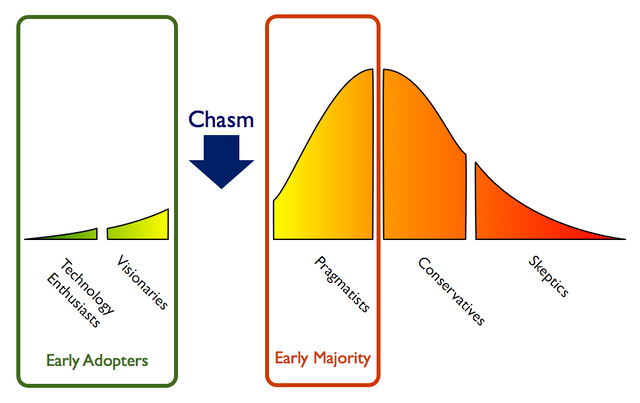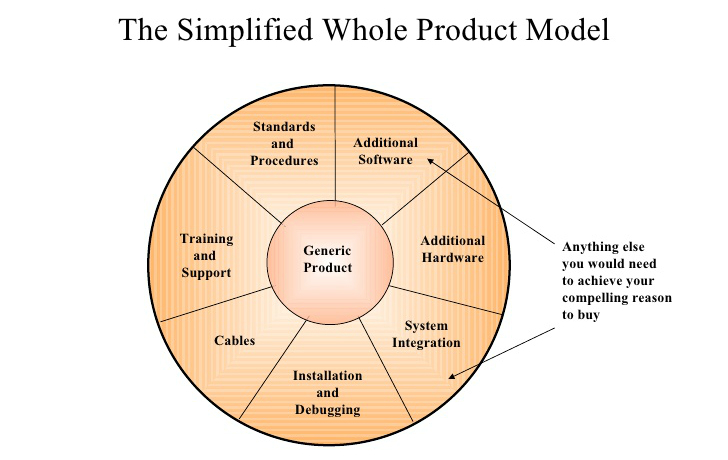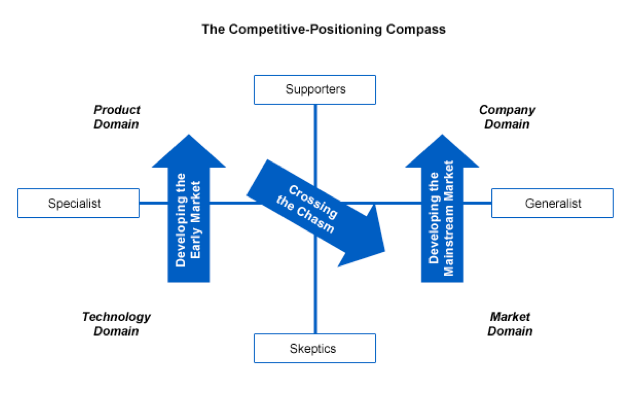Book Review - Crossing the Chasm

Marketing is one thing, but marketing a technology product is another beast altogether.
In his masterpiece "Crossing The Chasm", Geoffrey A. Moore lays out the foundational elements required in order to break through the hurdles that most entrepreneurs face when attempting to bring their high-tech product into the market.
It is a rarity to find a piece of literature related to business development that I would deem as "inspirational", however; this is such a piece.
Take the following excerpt for example which neatly wraps market penetration, niching, competitive analysis, and a lot of other highly complex topics into a single phrase:
"For a given target customer and a given application, create a marketplace in which your product is the only reasonable buying proposition."
The technology adoption cycle is a process that every technology company must persevere through, and despite the common misconception that it a smooth curve,
there is actually a giant crack that exists on the otherwise smooth trajectory.
If you want to get all the way through the entire technology adoption cycle, you have to market to each individual segment in a specific way,
or else your product just wont "stick"
Crossing the Chasm is about the gap that exists in the adoption cycle for any technology product between the Early Adopters and the Early Majority,
a problem that if left un-addressed will spell certain doom for any company foolish enough to ignore it.

Lets begin by discussing each of the segments above:
Innovators: The Technology Enthusiasts
Innovators appreciate technology for its own sake, they microscopically analyze the architecture,
and thoroughly understand the competitive advantage of your product.
They are the ones who buy high-tech items when they cost significantly more than what would be considered a "reasonable" rate.
Technology enthusiasts are the gatekeepers for any new technology,
they pose fewer requirements than any other group in the adoption profile.
They most important thing to understand is that they want the truth, without any tricks,
and they want the technical information down to the atomic level if possible.
They are great to deal with assuming that you have the latest and greatest technology, and don't need to make much money.
Early Adopters: The Visionaries
Early Adopters are a rare breed of people who have the insight to match an emerging technology to a strategic opportunity,
the temperament to translate that insight into a high-visibility and high-risk project,
and the charisma to get the rest of their organization to buy into that project.
They tend to be executives interested in taking quantum leaps forward instead of making incremental progress.
They are not looking for an improvement, they are looking for a fundamental breakthrough,
this is the least price-sensitive segment of the technolog adoption lifecycle.
They are easy to sell, but very hard to please.
Managing having a visionary as a client revolves around packaging the goals into different phases:
The goal is accomplishable by mere mortals working in earth time.
The goal provides the vendor with a marketable product.
The goal provides the customer with a concrete return on investment that can be celebrated as a major leap forward.
Early Majority: The Pragmatists
The Pragmatists represent the bulk of the market, if you have made it "in" with them, you have successfully crossed the chasm!
This is where the dollars are; you can succeed with the visionaries on having a break-through product,
but if you can't capture the Early Majority, your product will never really hit the market.
Low on drama, high on integrity and commitment.
If the goal of visionaries is to take a quantum leap forward, the goal of pragmatists is to make incremental, measurable, predictable progress.
They will take risks when required, but first they will put in place safety nets and manage the risks very closely.
Pragmatists are hard to win over, but they are loyal once won, and they are arguably the most leverageable of all market segments.
When they buy... they care about the company, the quality of the product, the infrastructure, and the reliability of hte service they are going to get.
Late Majority: The Conservatives
For every pragmatist, there is a conservative.
They tend to fear high-tech a bit, so they tend to invest at the end of the technology adoption lifecycle.
They want products that are extremely mature, low-priced, and the products themselves can be treated as commodities.
Conservatives do not have high aspirations about their high-tech investments, and hence will not support high price margins.
They want something that simply works at a reasonable price.
To successfully market to conservatives you must have thought thoroughly through the "white solution" to a their end-user's market's needs.
Laggards: The Skeptics
They do not participate in the high-tech marketplace, except to block purchases.
The primary objective when dealing with skeptics is to neutralize their influence.
Since skeptics will continuously point out discrepancies between your sales claims and your product features, you can use this information to improve your product.
Back to the Chasm
So now that we know all of the segments involved with the technology adoption cycle... now what?
Well because each segment of the technology adoption cycle references the others concerning buying decisions, it is important to start at the beginning and work our way forward.
The obvious solution to establishing a foothold with the innovators is niching down to their level.
If you are able to create a product that solves a particular need for a particular market segment, you are off to a good start.
"If you don't know where you are going, you will wind up somewhere else."
A Lack of Data
One of the biggest problems most technology companies face as they attempt to scale is a lack of available data relating to their specific market or product.
Many executives have lost countless nights sifting through spreadsheets, sorting data matrixes, and re-evaluating key objectives.
The problem is that hamsterwheeling through a lack of data simply doesn't work - you need a perspective shift.
Instead of attempting to use analytical reasoning to try and solve the problem, you need to use informated intuition.
Informed intuition does not rely on processing a statistically significant sample of data in order to achieve a given level of confidence.
Rather, it involves conclusions based on isolating a few high-quality images - really, data fragments - that it takes to be archetypes of a broader and more complex reality.
These images simply stand out from the swarm of mental material that rattles around in our heads.
If you can't remember it, don't try it, because it's not worth it - Only work with memorable images.
Warfare vs Wordfare
Now that you have freed yourself from analysis paralysis, it is critical to understand that marketing is warfare - not wordfare.
In order to properly orchestrate the strategy around your product, you first need to understand what The Whole Product actually is...

There is a gap between the product that is shipped, and what the customer expects -
the better you can close this gap, the better your product will resonate with your customers.
The single most important difference between early markets and mainstream markets is that
the former are willing to take responsibility for piecing together the whole product
(in return for getting a jump on their competition), whereas the later are not.
Failure to recognize this principle has been the downfall of many a high-tech enterprise.
The holy grail to crossing the chasm is:
Focus on the minimum commitment to the whole product that assures the target customers can fulfill their compelling reason to buy.
Competitive Positioning:
There are four domains of value in high-tech marketing:
Technology, Product, Market, and Company
As products move through the Technology Adoption Life Cycle, the domain of greatest value to the customer changes.
In the early market, where decisions are dominated by technology enthusiasts and visionaries, the key value domains are technology and product.
In the mainstream, where decisions are dominated by pragmatists and conservatieves, the key domains are market and company.
Crossing the chasm, in this context, represents a transition from product-based to market-based values:

The chart above should be self-explanatory, so we wont dive too deep into the details.
Now, since Steemit itself (...as well as blockchain, smart contracts, etc) is a part of this cycle, it begs the obvious question:
"Where are we now?"
Although one could argue that we are in the Early Adopter phase... how much will it take?
How much practical applicability will we have to see within the marketplace before we transcend the chasm and truly "break through" into the mainstream... and perhaps the bigger question is...
Do we even want to?
Just some thoughts, and remember:
"The fundamental rule of engagement is that any force can defeat any other force - if it can define the battle."
Perfectly!
Congratulations @draconum! You have completed some achievement on Steemit and have been rewarded with new badge(s) :
Click on any badge to view your own Board of Honnor on SteemitBoard.
For more information about SteemitBoard, click here
If you no longer want to receive notifications, reply to this comment with the word
STOPBy upvoting this notification, you can help all Steemit users. Learn how here!